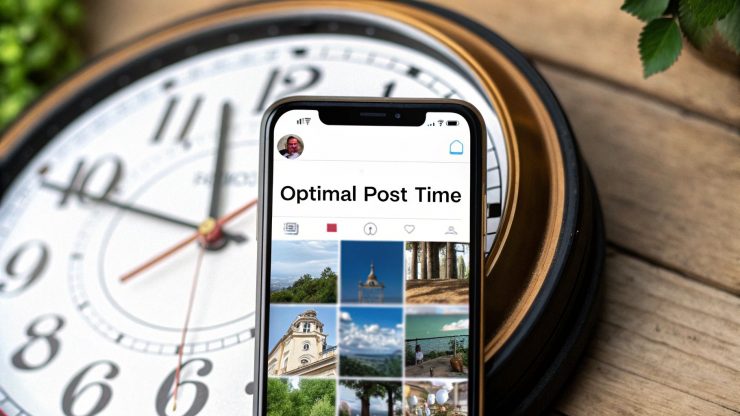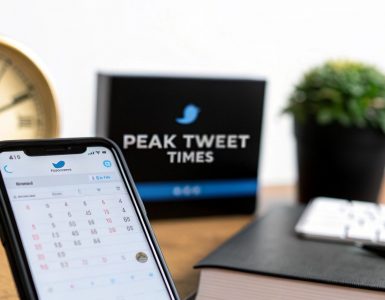On weekdays, the sweet spots for posting on Instagram tend to be between 11 AM and 1 PM and again from 7 PM to 9 PM. These windows typically catch people during their lunch breaks and as they're unwinding in the evening, giving your content a better shot at being seen right away.
Why Your Instagram Posting Time Matters More Than Ever
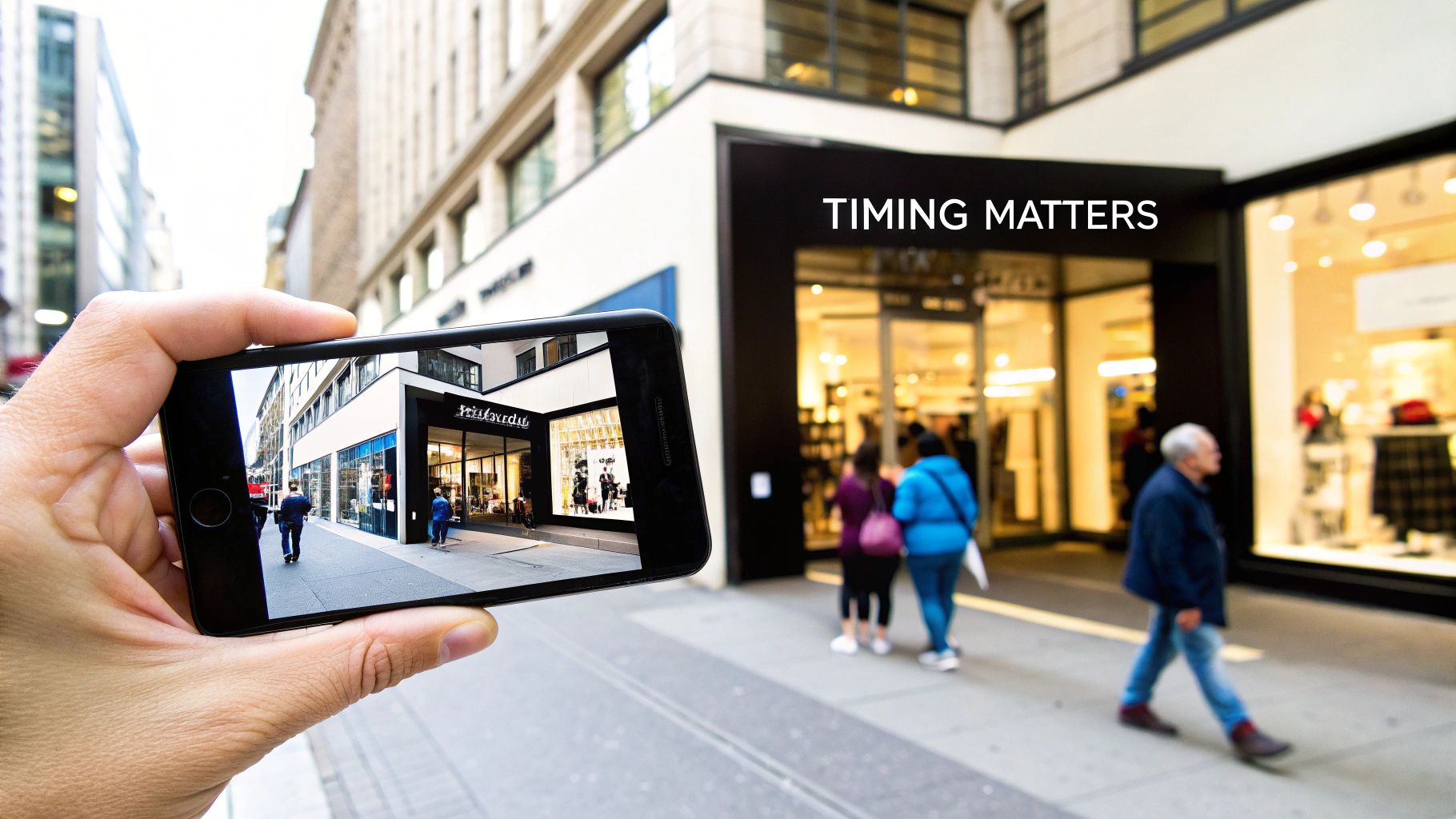
Imagine you've set up a fantastic pop-up shop with your best products. You wouldn't open at 3 AM when the streets are deserted, right? You'd open when the sidewalks are packed. Think of your Instagram feed the same way. Posting your best content when no one's around is a surefire way to waste all that hard work.
The "when" you post is just as important as the "what" you post, and it all comes down to the Instagram algorithm. The algorithm is obsessed with one thing: early engagement. It's looking for immediate signals—likes, comments, shares, and saves—that tell it your content is a hit.
The Power of Initial Velocity
When your post gets that first wave of interaction, it creates what we call "velocity." A post with high velocity gets an algorithmic thumbs-up, pushing it higher in your followers' feeds and even giving it a chance to land on the coveted Explore page.
On the flip side, if you post when your audience is asleep or busy, you get crickets. That silence tells the algorithm your post is a dud, and it gets buried before most of your followers even have a chance to see it. It's a simple feedback loop that makes or breaks your reach.
- Posting at Peak Times: More people are online, which means more initial engagement. The algorithm sees this, likes it, and shows your post to even more people.
- Posting at Off-Peak Times: Fewer people are online, so engagement is low. The algorithm assumes your content isn't interesting and hides it.
Posting at the right time isn't just about getting seen. It's about giving your content the initial momentum it needs to catch fire with the algorithm. Without that early push, even your best work can fall flat.
Establishing a Strong Foundation
Getting this concept down is the first real step to building an Instagram strategy that works. Before you start digging into your own analytics and running tests, it helps to have a solid starting point. And while every account’s audience is a little different, broad data shows us some clear patterns in user behavior.
Across the board, studies show that mid-day on weekdays (think lunch hour) and evenings are reliable times to post. You’re catching people when they take a break from work or are relaxing on the couch, scrolling for something interesting. This general advice gives you a reliable foundation to build on before we dive into the custom strategies that will really move the needle.
Understanding the Data Behind General Best Posting Times
Let's get one thing straight: there's no single "magic" time to post that guarantees viral success. Instead, think of it like a busy highway system. While your specific destination is unique, there are well-known rush hours when the roads are absolutely packed with traffic. Large-scale data reveals these digital rush hours on Instagram.
Starting with these general trends is the smartest first move. They aren't the final answer for your account, but they give you a data-backed foundation to build on. It's about avoiding the mistake of posting when the digital streets are completely empty. These popular engagement windows are tied directly to the daily routines millions of us share.
Decoding Daily Routines and Peak Times
So, why are certain hours consistently better? It all comes down to predictable human behavior. People grab their phones and open Instagram during the natural lulls in their day.
- The Morning Commute & First Break: A huge number of users scroll through their feeds on the way to work or during that first morning coffee.
- The Mid-Day Scroll: The lunch hour is prime time. It’s a built-in pause where people instinctively reach for their phones to unwind and catch up.
- The Post-Work Wind-Down: Once the workday is done, there's another major spike in activity as people relax on the couch and look for entertainment.
When you align your first few posts with these behavioral peaks, you're tapping into the natural rhythm of the platform. This gives you the best shot at capturing that crucial early engagement the algorithm loves, which helps give your content a stronger initial push. For a wider view, you can explore guides on the general best times to post on social media that cover other platforms, too.
The goal isn't just to post when people are online. It's to post right before the biggest waves of activity begin. This gives your content time to get picked up by the algorithm and surf that wave to maximum visibility.
This isn't just guesswork; it's backed by mountains of research from social media analytics firms. For instance, analysis in early 2025 revealed a nearly global pattern. One major study pinpointed a broad engagement peak between 10 AM and 3 PM—a window that lines up perfectly with work and school breaks. Another found strong results from posting earlier, between 7 AM and 9 AM, likely because it secures a spot in the feed before the day's competition really heats up.
A Consolidated View of Peak Posting Windows
While the exact hours can shift slightly, the underlying patterns are incredibly consistent. I've pulled together findings from several major studies to give you a clear, actionable starting point. Use this table as your baseline schedule before you start fine-tuning with your own analytics.
General Instagram Posting Times Based on Global Data
This table summarizes the most effective posting windows by day of the week, based on aggregated data from major social media studies.
| Day of the Week | High Engagement Time Slots (Local Time) | Reasoning (User Behavior) |
|---|---|---|
| Monday | 11 AM – 2 PM | Users catch up from the weekend and scroll during their lunch break. |
| Tuesday | 10 AM – 3 PM | A high-focus workday often leads to more frequent, short social media breaks. |
| Wednesday | 10 AM – 1 PM | Mid-week engagement is strong as people look for a distraction. |
| Thursday | 11 AM – 2 PM | Consistent mid-day activity continues as the week starts to wind down. |
| Friday | 10 AM – 1 PM | High engagement before the weekend; activity often drops in the afternoon. |
| Saturday | 9 AM – 11 AM | Many check their phones first thing in the morning before heading out. |
| Sunday | 5 PM – 8 PM | A major evening scroll session as users relax and prep for the week ahead. |
Think of these times as educated guesses powered by massive amounts of data. They represent your highest probability of reaching a broad audience. This is your starting line, not the finish line. The real magic happens when you take this general knowledge and test it against the unique behavior of your specific followers.
How to Find Your Unique Best Time to Post on Instagram
The general data is a fantastic starting point, but now it’s time to move beyond educated guesses and build a strategy that’s all your own. Think of the broad, best-time-to-post studies as a map of the main highways; your unique best time is the uncrowded side street that leads directly to your audience’s front door. To find it, you’ll need to do a little detective work, and your number one clue is your own Instagram Insights.
This free, built-in analytics tool is your secret weapon. It cuts through the noise of global averages and shows you exactly when your followers are actually online and scrolling. No more wondering when you should post—the answer is waiting right there for you.
Unlocking Your Data with Instagram Insights
First things first, you'll need a Business or Creator account to access this treasure trove of data. If you have a personal account, it only takes a second to switch over in your settings.
Once you’re set up, finding your audience data is simple:
- Head to your profile and tap the “Professional Dashboard” button.
- From there, navigate to “Total Followers.”
- Scroll all the way down, and you'll find the “Most Active Times” chart.
This chart is your roadmap. It visualizes the days and even the specific hours when your followers are most active on Instagram. You can toggle between "Hours" and "Days" to get a clearer picture, helping you pinpoint not just the best day but the peak hours within that day.
The infographic below shows how a typical user's activity ebbs and flows throughout the day, which is a great mental model to have as you look at your own data.
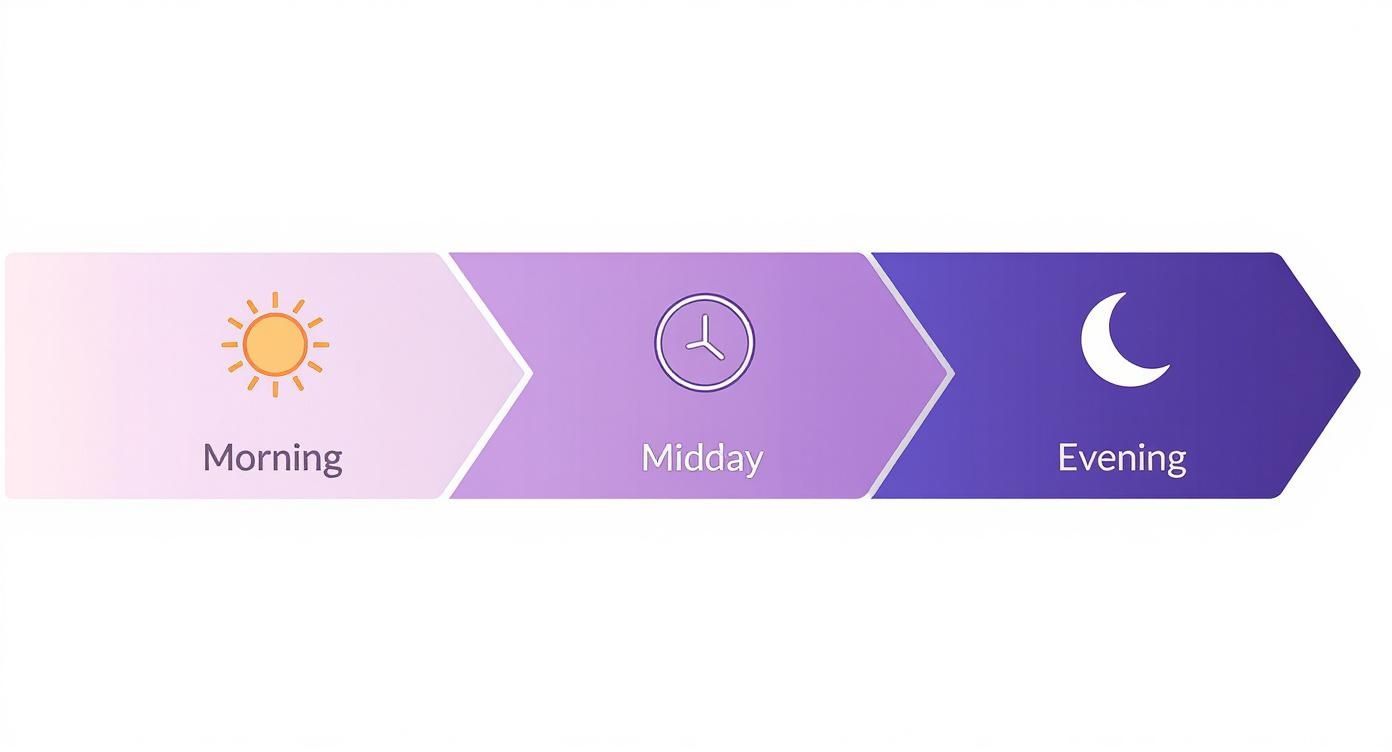
Your own analytics will either confirm this general rhythm or reveal a completely unique pattern for your specific audience.
Interpreting Your Peak Activity Chart
When you look at your "Most Active Times" chart, you’ll see some bars are a much darker shade of blue. These represent high activity, and those are your golden opportunities. For example, your data might show a massive spike on Wednesdays between 6 PM and 9 PM. That’s a clear signal to schedule your most important content right in that window.
Key Takeaway: Try posting about an hour before the peak activity really kicks off. This gives the Instagram algorithm enough time to index your content and start showing it to people. That way, your post is perfectly positioned to ride the wave of engagement when your audience floods the app.
To really get the most out of this, you’ll need to go beyond the chart and start understanding social media engagement metrics. This helps you see what's truly resonating with your followers, not just what's getting a few likes.
Putting Your Data to the Test
Your Insights chart gives you a strong hypothesis, but the final step is to prove it with a little real-world experimentation. This is where you can run some simple tests to validate what the data is telling you and fine-tune your schedule.
Here’s an easy framework to get started:
- Week 1: Pick your two most promising time slots from your Insights data (e.g., Wednesday at 6 PM and Thursday at 11 AM). Post similar types of content at these exact times.
- Week 2: Now, swap them. Post on Wednesday at 11 AM and Thursday at 6 PM.
- Analyze the Results: After two weeks, sit down and compare how all four posts performed. Pay close attention to engagement within the first one to three hours—this is the most critical period for the algorithm.
When you analyze, look beyond the surface. Track these key metrics:
- Likes and Comments: The most obvious signs of initial engagement.
- Shares and Saves: These are huge signals that tell the algorithm your content is valuable.
- Reach: How many unique accounts saw your post.
The key is to document everything. To keep it all organized, you might want to use something like this social media analytics report template. This kind of methodical process removes the guesswork and leaves you with a posting schedule that’s perfectly optimized for your audience.
Should My Reels, Stories, and Posts Go Live at the Same Time?
Thinking you can post everything at once is a classic mistake. It's like assuming every TV show should air during primetime. The morning news and a late-night talk show have completely different audiences and airtimes for a reason—and the same logic applies to your Instagram content.
Your Reels, Stories, and feed posts are all designed for different moments in your follower's day. A one-size-fits-all schedule just doesn't cut it. To really get this right, you have to think about matching the format to your audience's mindset. A quick, casual Story is perfect for a morning commute, while an entertaining Reel is what someone wants when they’re winding down for the evening.
Matching Your Content to Your Audience’s Day
Let's break down how people actually use each format. Stories are fleeting and informal, made for quick check-ins. Reels are built for discovery and entertainment, usually consumed when someone has time to kill. Feed posts and carousels are where you deliver solid value—something people might engage with more deeply during a work break.
When you create separate schedules for each format, you give every piece of content the best possible chance to shine.
- Instagram Stories: People tend to watch these in the "in-between" moments of their day—commuting, waiting for coffee, or taking a quick five-minute break from their desk. Their 24-hour lifespan creates a natural sense of urgency.
- Instagram Reels: This is pure downtime content. Reels do best when people are relaxing and actively looking for entertainment. That's why evenings and weekends are often a goldmine for Reel views.
- Feed Posts & Carousels: Since these posts are more permanent, they often perform well during focused breaks, like the lunch hour. This is when someone has a few minutes to actually read a caption, swipe through a carousel, and save a helpful tip.
The Best Times to Post by Content Format
Recent data shows just how different these engagement windows can be. For Instagram Reels, the evening hours between 6 PM and 10 PM are incredibly effective. This is when people are kicking back and ready to be entertained, which sends all the right signals to the algorithm. On the other hand, Instagram Stories often hit their peak from 8 AM to 12 PM, catching people during their morning routines and early work breaks. You can dig into more of these timing insights on Sprinklr.com.
Think of your content schedule as a daily story. You can start their morning with an engaging Story, grab their attention at lunch with a value-packed post, and entertain them in the evening with a killer Reel.
This approach means you're always meeting your audience where they are, with exactly the kind of content they're in the mood for. And if you're planning this far ahead, you'll probably find our guide on whether you can schedule a Story on Instagram super helpful for streamlining your process.
Your Industry Changes Everything
Beyond the format, your niche is a huge piece of the puzzle. The daily rhythm of a B2B executive is worlds apart from a college student's or a new parent's. Your schedule has to reflect the real-world lifestyle of the people you're trying to reach.
Just look at these examples:
- B2B Brands: Your audience is plugged in during the traditional 9-to-5 workday. Try posting educational carousels or industry news around lunchtime (12 PM – 2 PM) on weekdays when they're taking a screen break.
- Entertainment & Gaming: This world comes alive in the evenings and on weekends. An 8 PM post on a Friday is going to land much better than one at 8 AM on a Monday when their audience is just getting to work or school.
- Fashion & E-commerce: These brands often see big wins during lunch breaks and in the evening (7 PM – 9 PM). That’s when people are scrolling for outfit inspiration or doing a little online shopping after a long day.
Once you start layering these format- and industry-specific details, you're no longer just posting—you're being truly strategic, giving every post its best shot at success.
So, what do you do when your audience isn't all in one place?
Posting at 9 AM in New York is perfect for your East Coast followers, but that's already the middle of the afternoon in London and the dead of night in Sydney. This is exactly where a one-size-fits-all schedule falls flat. You've got to think bigger.
Your first move is to put on your detective hat. The best clues are waiting for you inside Instagram Insights. Just head to your Professional Dashboard > Total Followers and scroll down to the Top Locations section. This is where you’ll see a crystal-clear breakdown of the top countries and cities your followers call home.
Find Your Audience Hotspots
Once you know where your people are, you can stop guessing and start strategizing. Let's say you discover that, alongside your US followers, 30% of your audience is in the UK and another 20% is in Australia. Suddenly, you've got real data to work with. The vague problem of a "global audience" becomes a much more solvable puzzle.
From here, you have two solid ways to tackle this: either find a "golden hour" that bridges the gap or create a multi-post schedule that targets each region.
The point isn't to find a time that's perfect for everyone—that's a unicorn. The real goal is to find strategic windows that give your content the biggest bang for its buck across your most important audience groups.
Strategy 1: The "Golden Hour" Overlap
The most straightforward approach is to find a single time that works reasonably well for the largest chunks of your audience. It won’t be the absolute peak for every single person, but it can hit a sweet spot of significant overlap.
For instance, posting in the late afternoon on the US East Coast (say, around 4 PM EST) can be a great move. Think about who you're catching:
- East Coast US: People are starting to wind down their workday and check their phones.
- West Coast US: It’s lunchtime (1 PM PST), a prime time for scrolling.
- UK & Western Europe: It’s evening (9 PM GMT), when most are relaxing and catching up online.
This approach is wonderfully efficient. One post, three major regions covered during their active hours. It's a fantastic starting point for anyone who wants to reach a global audience without creating a monster content calendar.
Strategy 2: The Multi-Post Regional Plan
Now, if your audience is heavily split between a few very different time zones—like North America and Southeast Asia—you might need to get more targeted. This means posting the same content multiple times, scheduled specifically for each region's peak hours.
This strategy definitely takes more planning, but it can pay off with much higher engagement because you're meeting each audience right where they are, when they're most active. A scheduling tool is your best friend here; you simply can't be online 24/7. You could schedule a post for 9 AM in Paris for your European followers, and have that same great content go live again at 9 AM in Chicago for your North American base. Maximum visibility, without the burnout.
Using Scheduling Tools for Perfect Timing and Consistency
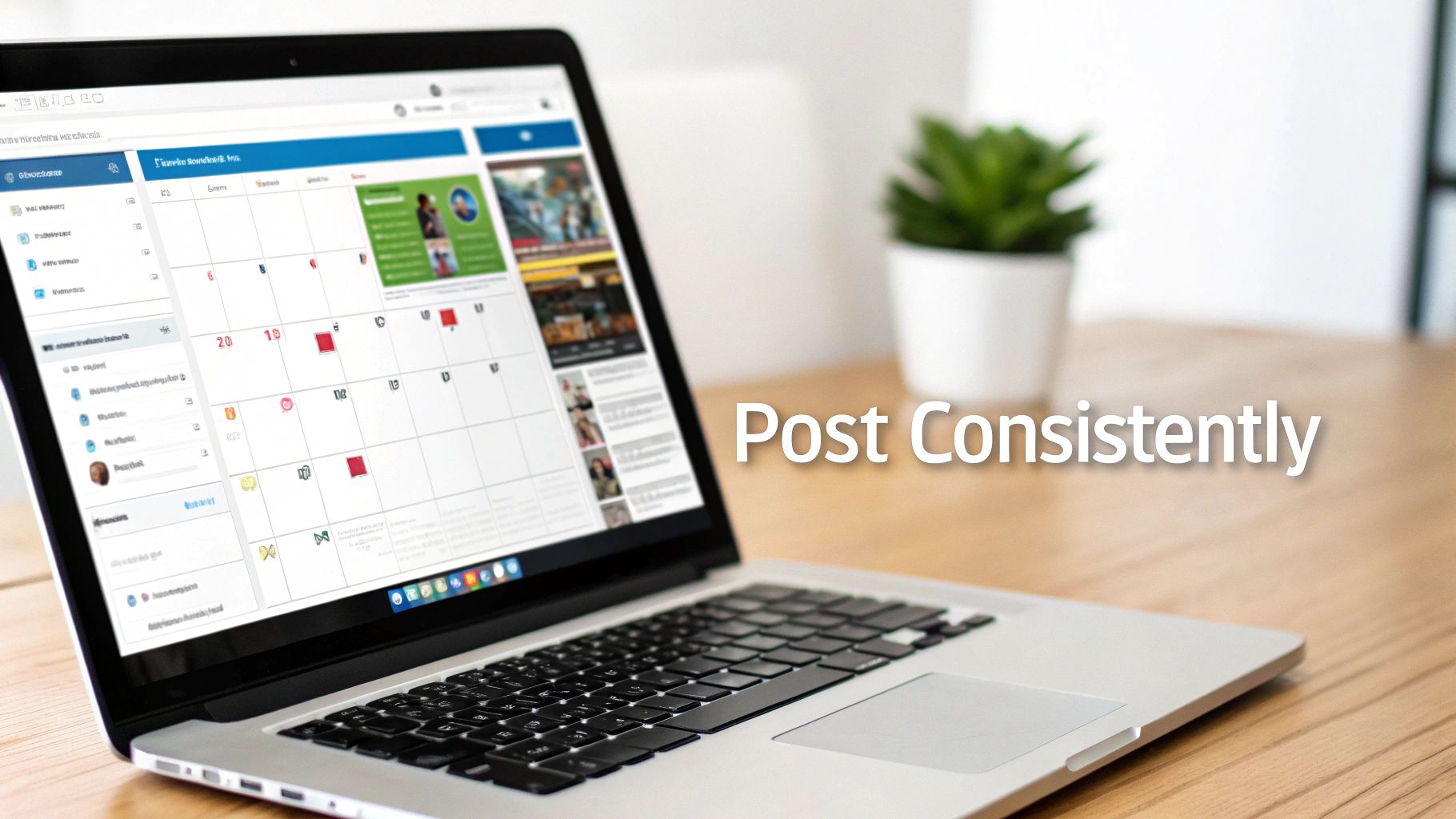
A brilliant strategy is only as good as its execution. You can spend hours poring over your Instagram Insights and pinpointing the exact moment your audience is most active, but if you aren't there to hit "Publish" at 9 PM on a Thursday, all that hard work goes to waste. This is exactly where scheduling tools become a social media manager's best friend.
Think of a scheduler as your personal assistant, one that never sleeps and ensures your content goes live at the perfect moment, every single time. Platforms like Buffer, Later, and RecurPost let you "set it and forget it," turning your carefully crafted schedule from a hopeful plan into a consistent reality. No more setting late-night alarms or interrupting dinner just to get a post out on time.
Why Automation Is Non-Negotiable
Consistency is one of the most powerful signals you can send to the Instagram algorithm. When you post reliably at the times your audience is online and engaged, you’re essentially training the algorithm to expect great content from you during those windows. Scheduling tools make this consistency effortless.
Even better, they give you back your time. Instead of the daily scramble to create and post, you can batch your work—scheduling a whole week or even a month of content in a single afternoon. Our own guide on how to schedule social media posts walks through just how much more efficient this makes your entire workflow.
The real power of scheduling isn't just about saving time; it's about guaranteeing your content gets its best chance to succeed by consistently hitting those peak engagement windows you worked so hard to find.
This consistency really does pay off. An analysis of over 2 million Instagram data points found that evening time slots consistently drive better engagement. The single best hour was on Thursdays at 9 PM Eastern Time, with Sunday and Wednesday evenings also showing standout performance. You can dig into the specifics in this in-depth analysis of Instagram engagement. With a scheduler, you never have to miss these prime opportunities again.
Choosing the Right Tool for the Job
While most scheduling tools handle the basics, many have special features that make them a better fit for certain users. Whether you're a solo creator focused on aesthetics or a large marketing team juggling multiple accounts, there's a platform built for you.
Here's a quick comparison to help you figure out which tool might be the best match for your Instagram strategy.
Comparison of Popular Instagram Scheduling Tools
This table provides a quick overview of leading scheduling tools to help you automate your posting strategy.
| Tool Name | Key Feature for Timing | Best For |
|---|---|---|
| Buffer | Simple, intuitive queue-based scheduling and a clean interface. | Solo creators and small businesses who need straightforward, reliable scheduling. |
| Later | Visual planner that allows you to see how your feed will look. | Brands and creators focused on maintaining a specific feed aesthetic. |
| RecurPost | Content libraries and evergreen post recycling for automated content rotation. | Marketers and agencies managing large volumes of evergreen content. |
At the end of the day, using any professional scheduler is a massive upgrade from posting manually. It frees you from the tyranny of the clock, helps you serve a global audience, and builds the kind of consistent presence that both your followers and the algorithm love.
Common Questions About Finding Your Best Instagram Time
Even with all the data in the world, a few specific questions always pop up when you're trying to nail down your perfect posting schedule. Let's tackle some of the most common ones.
Does Posting More Often Change My "Best Time"?
It definitely can. If you're posting several times a day, you're not looking for a single "best time" anymore. Instead, you’re hunting for multiple windows where your audience is active.
But remember, it’s always quality over quantity. It's far better to share one incredible post at your absolute peak time than it is to publish three mediocre ones throughout the day. Focus on locking down your top one or two time slots first and build from there.
How Often Should I Revisit My Posting Schedule?
Think of it like a monthly check-up. A quick look at your Instagram Insights once a month is a great rhythm to get into. Audience habits aren't set in stone—they can drift with the seasons, holidays, or even as your content style evolves.
My Two Cents: A monthly review is the sweet spot. It's frequent enough to catch new trends but not so often that you're chasing every tiny, meaningless blip in your engagement data.
This keeps you sharp and your timing relevant without adding a ton of extra work to your plate.
Is Posting Late at Night Ever a Good Idea?
For most brands, it's a no-go. Your content gets published while your audience is asleep, so it’s buried by the time they wake up and start scrolling. You completely miss out on that initial burst of likes and comments that the algorithm loves.
The only exception? If your analytics specifically show a huge chunk of your audience is awake and active then. This might happen if you cater to night-shift workers or have a big following in a completely different time zone. Otherwise, avoid it.
What About Weekends? Should I Post Then?
Absolutely! But—and this is a big but—you have to check your data first. It really depends on who you're talking to.
For many B2C brands in spaces like retail, food, or entertainment, weekends are pure gold. People have more downtime and are scrolling for fun. On the flip side, a lot of B2B accounts see engagement fall off a cliff after 5 PM on Friday. The only way to know for sure is to dive into your Insights and see what your audience does on Saturdays and Sundays.
Tired of playing the guessing game? EvergreenFeed can help you automate your posting schedule so your best content always hits your feed at the right moment. Stop doing the manual work and start getting real results. You can try EvergreenFeed for free and see the difference it makes.

